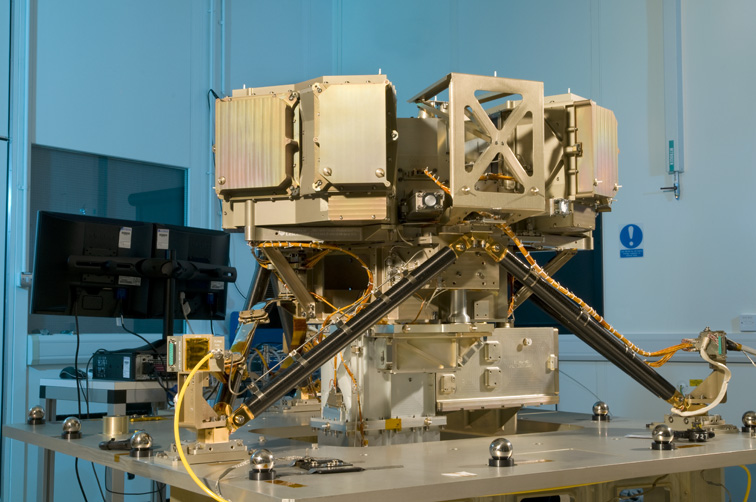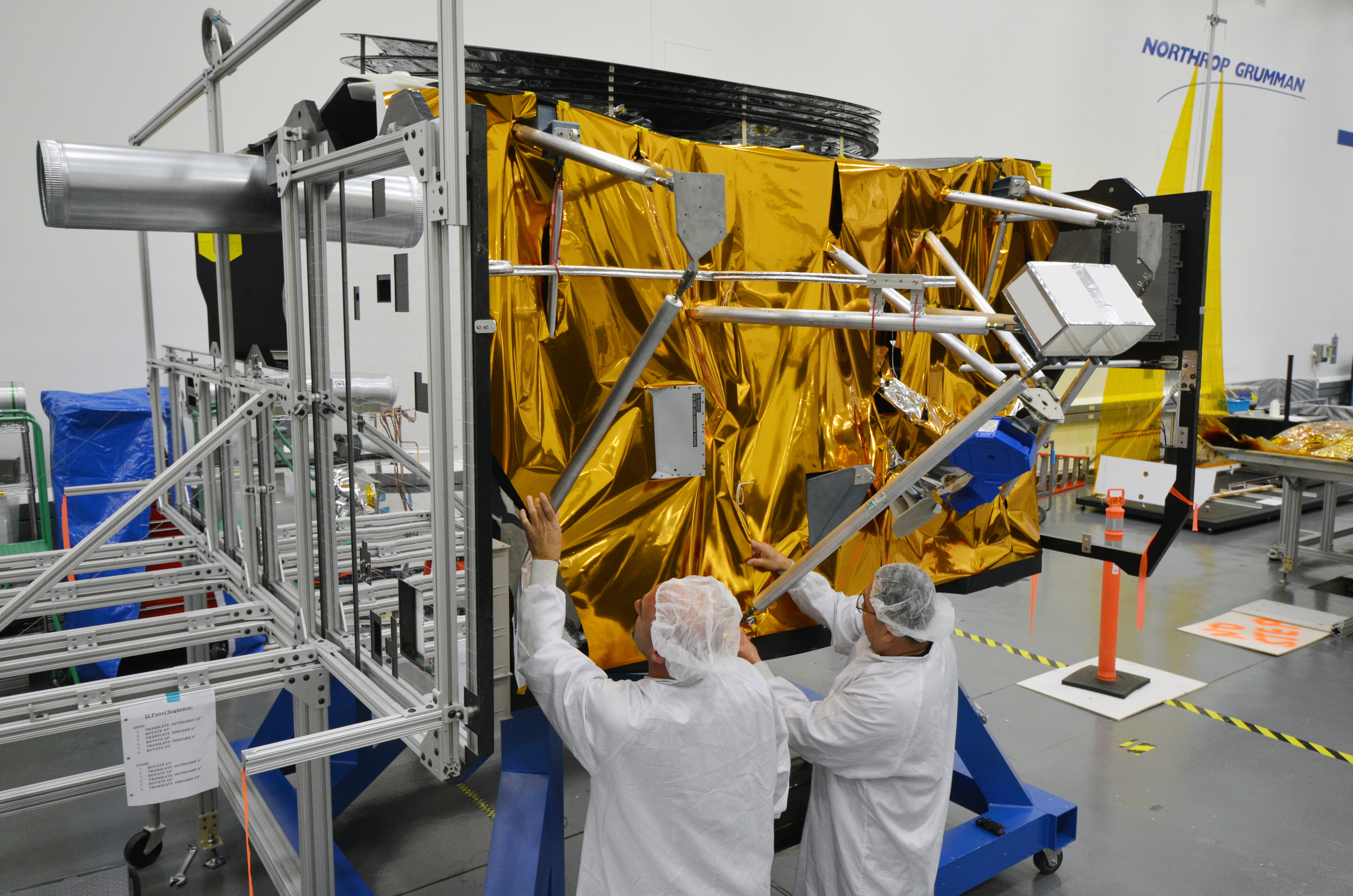|
Integrated Science Instrument Module
Integrated Science Instrument Module (ISIM) is a component of the James Webb Space Telescope, a large international infrared space telescope launched on . ISIM is the heart of the JWST, and holds the main science payload which includes four science instruments and the fine guidance sensor. ISIM is the spacecraft chassis and instruments that take the light from the main mirror and convert that into the science data that is then sent back to Earth. The other two major sections of the JWST are the Optical Telescope Element (OTE) (mirrors and their structure) and the Spacecraft Element (SE), which includes the spacecraft bus and sunshield. ISIM has a mass of 1400 kg (3086 lb), about 23% of the mass of the JWST. The infrared camera instrument integrated with ISIM passed its thermal tests in early 2016. ISIM underwent intense thermal cold testing in late 2015 to early 2016. NIRcam is extremely important to JWST, because it's not only a sensitive infrared camera, but it is also us ... [...More Info...] [...Related Items...] OR: [Wikipedia] [Google] [Baidu] |
ISIM 3 Logical Region
ISIM or iSIM may refer to: * International Society for Invertebrate Morphology * Institute for the Study of International Migration * IP Multimedia Services Identity Module * Integrated Science Instrument Module Integrated Science Instrument Module (ISIM) is a component of the James Webb Space Telescope, a large international infrared space telescope launched on . ISIM is the heart of the JWST, and holds the main science payload which includes four scienc ... * iSIM (subscriber identity module), a type of SIM directly integrated into a device's chipset See also : {{Disambig ... [...More Info...] [...Related Items...] OR: [Wikipedia] [Google] [Baidu] |
MIRI (Mid-Infrared Instrument)
MIRI, or Mid-Infrared Instrument, is an instrument on the James Webb Space Telescope. MIRI is a camera and a spectrograph that observes mid to long infrared radiation from 5 to 28 microns. It also has coronagraphs, especially for observing exoplanets. Whereas most of the other instruments on Webb can see from the start of near infrared, or even as short as orange visible light, MIRI can see longer wavelength light. MIRI uses silicon arrays doped with arsenic to make observations at these wavelengths. The imager is designed for wide views but the spectrograph has a smaller view. Because it views the longer wavelengths it needs to be cooler than the other instruments (see Infrared astronomy), and it has an additional cooling system. The cooling system for MIRI includes a Pulse Tube precooler and a Joule-Thomson Loop heat exchanger. This allowed MIRI to be cooled down to a temperature of 7 kelvins during operations in space. Overview The spectrograph can observe wavelengths be ... [...More Info...] [...Related Items...] OR: [Wikipedia] [Google] [Baidu] |
Spacecraft Bus (James Webb Space Telescope)
The spacecraft bus is the primary support element of the James Webb Space Telescope, launched on . It hosts a multitude of computing, communication, propulsion, and structural components. The other three elements of the JWST are the Optical Telescope Element (OTE), the Integrated Science Instrument Module (ISIM) and the sunshield. Region 3 of ISIM is also inside the spacecraft bus. Region 3 includes the ISIM Command and Data Handling subsystem and the Mid-Infrared Instrument (MIRI) cryocooler. The spacecraft bus must structurally support the 6.5 ton space telescope, while weighing only . It is made primarily of graphite composite material. It was assembled in the U.S. state of California by 2015, and then it had to be integrated with the rest of the space telescope leading up to its planned 2018 launch. The bus can provide pointing precision of one arcsecond and isolates vibration down to two milliarcseconds. The fine pointing is done by the JWST fine guidance mirror, obviating t ... [...More Info...] [...Related Items...] OR: [Wikipedia] [Google] [Baidu] |
European Space Agency
, owners = , headquarters = Paris, Île-de-France, France , coordinates = , spaceport = Guiana Space Centre , seal = File:ESA emblem seal.png , seal_size = 130px , image = Views in the Main Control Room (12052189474).jpg , size = , caption = , acronym = , established = , employees = 2,200 , administrator = Director General Josef Aschbacher , budget = €7.2 billion (2022) , language = English and French (working languages) , website = , logo = European Space Agency logo.svg , logo_caption = Logo , image_caption = European Space Operations Centre (ESOC) Main Control Room The European Space Agency (ESA; french: Agence spatiale européenne , it, Agenzia Spaziale Europea, es, Agencia Espacial Europea ASE; german: Europäische Weltraumorganisation) is an intergovernmental organisation of 22 member states dedicated to the exploration of space. Established in 1975 and headquartered i ... [...More Info...] [...Related Items...] OR: [Wikipedia] [Google] [Baidu] |
SpaceWire
SpaceWire is a spacecraft communication network based in part on the IEEE 1355 standard of communications. It is coordinated by the European Space Agency (ESA) in collaboration with international space agencies including NASA, JAXA, and RKA. Within a SpaceWire network the nodes are connected through low-cost, low- latency, full-duplex, point-to-point serial links, and packet switching wormhole routing routers. SpaceWire covers two (physical and data-link) of the seven layers of the OSI model for communications. Architecture Physical layer SpaceWire's modulation and data formats generally follow the data strobe encoding - differential ended signaling (DS-DE) part of the IEEE Std 1355-1995. SpaceWire utilizes asynchronous communication and allows speeds between 2 Mbit/s and 200 Mbit/s, with initial signalling rate of 10Mbit/s. DS-DE is well-favored because it describes modulation, bit formats, routing, flow control, and error detection in hardware, with little need for soft ... [...More Info...] [...Related Items...] OR: [Wikipedia] [Google] [Baidu] |
Mid-infrared
Infrared (IR), sometimes called infrared light, is electromagnetic radiation (EMR) with wavelengths longer than those of visible light. It is therefore invisible to the human eye. IR is generally understood to encompass wavelengths from around 1 millimeter (300 GHz) to the nominal red edge of the visible spectrum, around 700 nanometers (430 THz). Longer IR wavelengths (30 μm-100 μm) are sometimes included as part of the terahertz radiation range. Almost all black-body radiation from objects near room temperature is at infrared wavelengths. As a form of electromagnetic radiation, IR propagates energy and momentum, exerts radiation pressure, and has properties corresponding to both those of a wave and of a particle, the photon. It was long known that fires emit invisible heat; in 1681 the pioneering experimenter Edme Mariotte showed that glass, though transparent to sunlight, obstructed radiant heat. In 1800 the astronomer Sir William Herschel discovered tha ... [...More Info...] [...Related Items...] OR: [Wikipedia] [Google] [Baidu] |
NASA
The National Aeronautics and Space Administration (NASA ) is an independent agency of the US federal government responsible for the civil space program, aeronautics research, and space research. NASA was established in 1958, succeeding the National Advisory Committee for Aeronautics (NACA), to give the U.S. space development effort a distinctly civilian orientation, emphasizing peaceful applications in space science. NASA has since led most American space exploration, including Project Mercury, Project Gemini, the 1968-1972 Apollo Moon landing missions, the Skylab space station, and the Space Shuttle. NASA supports the International Space Station and oversees the development of the Orion spacecraft and the Space Launch System for the crewed lunar Artemis program, Commercial Crew spacecraft, and the planned Lunar Gateway space station. The agency is also responsible for the Launch Services Program, which provides oversight of launch operations and countdown management f ... [...More Info...] [...Related Items...] OR: [Wikipedia] [Google] [Baidu] |
Fine Guidance Sensor And Near Infrared Imager And Slitless Spectrograph
Fine Guidance Sensor and Near Infrared Imager and Slitless Spectrograph (FGS-NIRISS) is an instrument on the James Webb Space Telescope (JWST) that combines a Fine Guidance Sensor and a science instrument, a near-infrared imager and a spectrograph. The FGS/NIRISS was designed by the Canadian Space Agency (CSA) and built by Honeywell as part of an international project to build a large infrared space telescope with the National Aeronautics and Space Administration (NASA) and the European Space Agency (ESA). FGS-NIRISS observes light from the wavelengths of 0.8 to 5.0 microns. The instrument has four different observing modes. Physically the FGS and NIRISS are combined, but optically they are separate with the FGS being used by the telescope to point it, whereas NIRISS is an independent science instrument. The spectroscopic mode is capable of doing exoplanet spectroscopy. The detector for NIRISS is a 2048 × 2048 pixel mercury cadmium telluride (HgCdTe) array, where each pixel is ... [...More Info...] [...Related Items...] OR: [Wikipedia] [Google] [Baidu] |
NIRSpec (Near-Infrared Spectrograph)
The NIRSpec (Near-Infrared Spectrograph) is one of the four scientific instruments flown on the James Webb Space Telescope (JWST). The JWST is the follow-on mission to the Hubble Space Telescope (HST) and is developed to receive more information about the origins of the universe by observing infrared light from the first stars and galaxies. In comparison to HST, its instruments will allow looking further back in time and will study the so-called Dark Ages during which the universe was opaque, about 150 to 800 million years after the Big Bang. The NIRSpec instrument is a multi-object spectrograph and is capable of simultaneously measuring the near-infrared spectrum of up to 100 objects like stars or galaxies with low, medium and high spectral resolutions. The observations are performed in a 3 arcmin × 3 arcmin field of view over the wavelength range from 0.6 µm to 5.0 µm. It also features a set of slits and an aperture for high contrast spectroscopy of individual sources, ... [...More Info...] [...Related Items...] OR: [Wikipedia] [Google] [Baidu] |
James Webb Space Telescope
The James Webb Space Telescope (JWST) is a space telescope which conducts infrared astronomy. As the largest optical telescope in space, its high resolution and sensitivity allow it to view objects too old, distant, or faint for the Hubble Space Telescope. This will enable investigations across many fields of astronomy and cosmology, such as observation of the first stars, the formation of the first galaxies, and detailed atmospheric characterization of potentially habitable exoplanets. The U.S. National Aeronautics and Space Administration (NASA) led JWST's design and development and partnered with two main agencies: the European Space Agency (ESA) and the Canadian Space Agency (CSA). The NASA Goddard Space Flight Center (GSFC) in Maryland managed telescope development, the Space Telescope Science Institute in Baltimore on the Homewood Campus of Johns Hopkins University operates JWST, and the prime contractor was Northrop Grumman. The telescope is named after James E. Webb, ... [...More Info...] [...Related Items...] OR: [Wikipedia] [Google] [Baidu] |
NIRCam
NIRCam (Near-InfraRed Camera) is an instrument aboard the James Webb Space Telescope. It has two major tasks, as an imager from 0.6 to 5 micron wavelength, and as a wavefront sensor to keep the 18-section mirrors functioning as one. In other words, it is a camera and is also used to provide information to align the 18 segments of the primary mirror. It is an infrared camera with ten mercury-cadmium-telluride (HgCdTe) detector arrays, and each array has an array of 2048×2048 pixels. The camera has a field of view of 2.2×2.2 arc minutes with an angular resolution of 0.07 arcsec at 2 microns. NIRCam is also equipped with coronagraphs, which helps to collect data on exoplanets near stars. It helps with imaging anything next to a much brighter object, because the coronagraph blocks that light. NIRCam is housed in the Integrated Science Instrument Module (ISIM), to which it is attached by struts. It is designed to operate at , so it can detect infrared radiation at this wavelength. ... [...More Info...] [...Related Items...] OR: [Wikipedia] [Google] [Baidu] |







